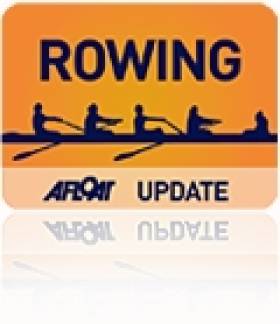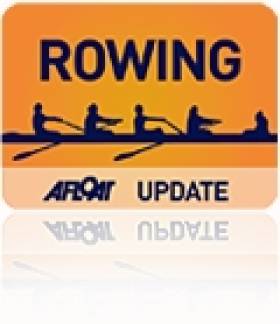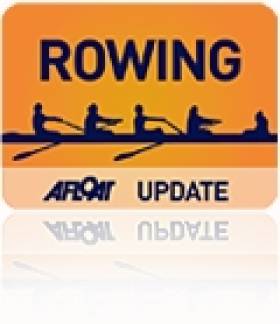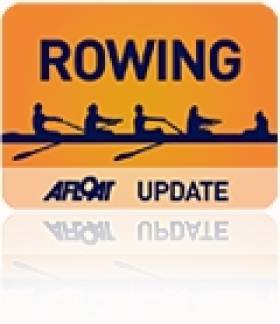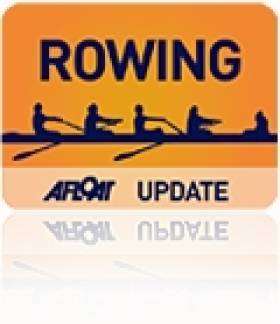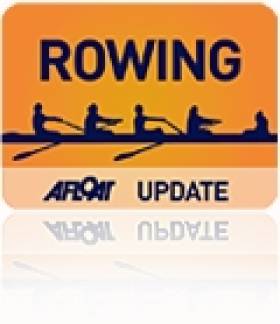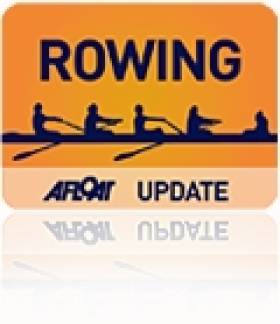Displaying items by tag: Rowing,
Spirited Performance Puts Young Ireland Crew in Semi-Finals of World Rowing Championships
# ROWING: The Ireland junior women’s quadruple of Katie Cromie, Hilary Shinnick, Bridget Jacques and stroke woman Bernadette Walsh showed great character to take third in their repechage and qualify for the semi-finals of the World Rowing Championships in Plovdiv in Bulgaria today.
Three places were available, and in the early stages it seemed that eventual winners Germany would be joined by Italy and Denmark. Behind them the young Ireland crew were battling with Ukraine for fourth. But by halfway the Irish, roared on by their support, were closing in on Denmark. They passed the Danes in the next 500 metres and fought off their attempts to regain third in the final quarter.
All but Cromie in the Ireland crew are 17 years of age.
World Senior and Junior Rowing Championships, Plovdiv, Bulgaria – Day Two (Irish interest)
Men
Junior Pair – Heat Three (Winner directly to A/B Semi-Final; rest to repechages): 1 Romania 6:46.98, 2 Germany 6:53.83, 3 Poland 6:58.00, 4 Ireland (C Black, J Cassells) 6:59.13, 5 Estonia 7:13.74.
Junior Single Scull – Heat Four (First Four to Quarter-Finals): 1 China (G Li) 7:08,24, 2 Ireland (P O’Donovan) 7:13.05, 3 Zimbabwe (P Purcell Gilpin) 7:14.77, 4 Estonia (A Luenekund) 7:22.12; 5 Japan 7:27.06.
Women
Junior Quadrple – Repechage One (First Three to A/B Semi-Final; rest to C Final): 1 Germany 6:38.45, 2 Italy 6:43.88, 3 Ireland (K Cromie, H Shinnick, B Jacques, B Walsh) 6:46.34; 4 Denmark 6:47.68, 5 Ukraine 7:02.24.
Junior Single Scull – Heat Four (Four Guaranteed Quarter-Finals; fastest of rest to Quarter-Finals; rest to Final E): 1 Belarus (K Staraselets) 7:57.89, 2 Chile (N Sanchez Rojas) 8:09.53, 3 Ireland (K O’Brien) 8:13.90, 4 Ukraine (D Serebrianska) 8:16.83; 5 Uganda 10:14.48.
# ROWING: Paul O’Donovan took second in his heat of the junior single sculls to ease into the quarter-finals of the World Rowing Championships in Plovdiv in Bulgaria. China’s Ganggang Li ran away with the race. Four of the five crews qualified, but the big Chinese sprinted away from the rest and was never caught. O’Donovan came closest, but even the pugnacious Skibbereen man could not wrest the lead from Li Ganggang. Zimbabwe and Estonia took third and fourth, while Japan, in fifth, lost out.
Kate O’Brien will also compete in the quarter-finals of the junior women’s single scull. A good scull in her heat by the St Michael’s athlete saw her take third place behind Belarus and Chile and ahead of Ukraine, with all four qualifying.
World Senior and Junior Rowing Championships, Plovdiv, Bulgaria – Day Two (Irish interest)
Men
Junior Pair – Heat Three (Winner directly to A/B Semi-Final; rest to repechages): 1 Romania 6:46.98, 2 Germany 6:53.83, 3 Poland 6:58.00, 4 Ireland (C Black, J Cassells) 6:59.13, 5 Estonia 7:13.74.
Junior Single Scull – Heat Four: 1 China (G Li) 7:08,24, 2 Ireland (P O’Donovan) 7:13.05, 3 Zimbabwe (P Purcell Gilpin) 7:14.77, 4 Estonia (A Luenekund) 7:22.12; 5 Japan 7:27.06.
Women
Junior Single Scull – Heat Four (Four Guaranteed Quarter-Finals; fastest of rest to Quarter-Finals; rest to Final E): 1 Belarus (K Staraselets) 7:57.89, 2 Chile (N Sanchez Rojas) 8:09.53, 3 Ireland (K O’Brien) 8:13.90, 4 Ukraine (D Serebrianska) 8:16.83; 5 Uganda 10:14.48.
# ROWING: Ireland’s Chris Black and Joel Cassells must negotiate a repechage to make the A/B semi-finals of the junior men’s pair at the World Rowing Championships in Plovdiv in Bulgaria. The Bann crew found themselves in the fastest heat of four this morning and finished fourth. Romania set the pace and won in a quick time of six minutes 46.98 seconds despite the challenge of Germany and Ireland over the first half of the race. Poland took over from Ireland in third in the closing stages and held off a late push by Black and Cassells.
World Senior and Junior Rowing Championships, Plovdiv, Bulgaria – Day Two (Irish interest)
Men
Junior Pair – Heat Three (Winner directly to A/B Semi-Final; rest to repechages): 1 Romania 6:46.98, 2 Germany 6:53.83, 3 Poland 6:58.00, 4 Ireland (C Black, J Cassells) 6:59.13, 5 Estonia 7:13.74.
# ROWING: Niall Kenny claimed third place in his heat of the lightweight single sculls to progress to the quarter-finals of the World Senior and Junior Rowing Championships in Plovdiv in Bulgaria today. The Galway man slotted in behind Hungary and Poland and ahead of Korea to guarantee himself meaningful action tomorrow.
The lightweight men’s pair finished fifth and last in a fascinating heat. Just one crew moved directly into the semi-finals. Germany looked like that crew until the final 500 metres, when they folded under pressure from the United States, who won, and Denmark, who took second.
Claire Lambe was in an extremely difficult heat of the lightweight single sculls. Alexandra Tsiavou of Greece was fresh from claiming bronze at the Olympic Games in the lightweight double scull – and proved fresh in competition as well, giving no encouragement to ther opposition as she grabbed hold of the one direct qualification place for the semi-finals. Lambe could not shift out of fifth and will compete in a repechage tomorrow.
World Rowing Championships, Plovdiv, Bulgaria – Day One (Irish interest)
Men
Lightweight Pair – Heat Three (Winner directly to A/B Semi-Finals; rest to repechages): 1 United States 6:49.02, 2 Denmark 6:49.61, 3 Germany 6:53.94, 4 Serbia 6:59.78, 5 Ireland (M O’Donovan, A English) 7:02.51.
Lightweight Single Scull – Heat Four (First Three and fastest losers to Quarter-Finals): 1 Hungary (P Galambos) 7:14.16, 2 Poland (B Lesniak) 7:15.33, 3 Ireland (N Kenny) 7:24.91; 4 Korea 7:31.27.
Women
Lightweight Single Scull – Heat Three: (Winner directly to A/B Semi-Finals; rest to repechages): 1 Greece (A Tsiavou) 7:49.89; 2 Belarus 7:52.99, 3 United States 7:54.22, 4 Australia 7:58.28, 5 Ireland (C Lambe) 8:06.07, 6 Kuwait 9:34.72
Junior Quadruple Scull – Heat Two (First Two to Semi-Final A/B, rest to repechage): 1 Romania 6:36.54, 2 New Zealand 6:39.41; 5 Ireland 7:00.39.
Ireland Crews Begin Programme at World Rowing Championships
# ROWING: Ireland began their campaign in the World Senior and Junior Rowing Championships today at Plovdiv in Bulgaria. The senior programme is for non-Olympic events. The Ireland team has been boosted by the inclusion of Claire Lambe in the lightweight single scull. The first Ireland crew in action was the junior women’s quadruple, which finished fifth and must compete in a repechage tomorrow. The were not helped by catching a crab (missing a stroke) in the middle of the race.
World Rowing Championships, Plovdiv, Bulgaria – Day One (Irish interest)
Women
Junior Quadruple Scull – Heat Two (First Two to Semi-Final A/B, rest to repechage): 1 Romania 6:36.54, 2 New Zealand 6:39.41; 5 Ireland 7:00.39.
Just Two Senior Ireland Crews For World Rowing Championships
# ROWING: Ireland will field just two senior crews at next week’s World Senior and Junior Rowing Championships in Plovdiv in Bulgaria. The lightweight men’s pair of Mark O’Donovan and Anthony English will be joined by lightweight single sculler Niall Kenny. The senior events are for crews in non-Olympic events.
The four junior crews representing Ireland will be a women’s quadruple scull, the men’s pair of Chris Black and Joel Cassells and single scullers Paul O’Donovan and Kate O’Brien.
Competition at the Championships begins on Wednesday and runs through to Sunday.
Rowing Ireland Looks for New HPD as McElroy Steps Down
# ROWING: Martin McElroy, the Ireland High Performance Director, will not be seeking renewal of his contract when it finishes at the end of next month. The Galway man took up work as HPD in 2009, stressing that his priority was to build a sustainable system, and one which would outlast him.
Forming a strong under-23 group was a priority, and there were successes here, including a silver medal for the men’s lightweight quadruple at the World Under-23 Championships in 2010. Ten athletes represented Ireland at this year’s World Under-23 Championships.
A team of coaches was also formed and the National Rowing Centre became the base for an ambitious group of athletes.
However, just one senior athlete competed for Ireland at the Olympic Games - Sanita Puspure finished 13th in the single sculls. The strong hopes for the lightweight double scull of Siobhan McCrohan and Claire Lambe ended controversially when McCrohan was cut because of difficulties making the weight.
Rowing Ireland has advertised for a new HPD, with entries closing on September 14th.
Puspure Ends Well at Olympic Rowing Regatta With Win in C Final
# ROWING: Sanita Puspure won the C Final of the women’s single sculls with great ease at the Olympic Games regatta at Eton Dorney today, placing her 13th overall. Micheen Thornycroft of Zimbabwe showed well early on, but Puspure took over in the second quarter of the race and had a clear one-length lead by 1250 metres. She then pushed on to win by almost eight seconds.
The A Final winner was Mirka Knapkova of the Czech Republic. Silver and bronze went to Fie Udby Erichsen of the Denmark and Kim Crow of Australia.
In an interesting twist, the Olympic Qualification Regatta in Lucerne had been a good indicator of form at Eton Dorney. Crow had won there, while Erichsen had finished second. Genevra Stone of the United States, who was third in Lucerne, won the Olympic B Final (seventh overall), while Puspure was fourth in Lucerne. Crow had a great Olympics, taking silver in the double sculls.
Olympic Games Regatta, Eton Dorney (Irish interest)
Women’s Single Sculls – C Final (places 13 to 18): 1 Ireland (S Puspure) 7:59.77, 2 Zimbabwe (M Thornycroft) 8:07.52, 3 Cuba (Y Cobas Garcia) 8:14.59, 4 El Salvador 8:19.75, 5 Thailand 8:34.11, 6 Brazil did not start. A Final: 1 Czech Republic (M Knapkova) 7:54.37, 2 Denmark (FU Erichsen) 7:57.72, 3 Australia (K Crow) 7:58.04.
Tearful Campbell Finally Lands His Olympic Medal
# ROWING: Alan Campbell took his first Olympic medal in three attempts at Eton Dorney today. The 29-year-old Coleraine man, who competes for Britain, took bronze by fighting off Sweden’s Lassi Karonen in a race which brought Mahe Drysdale gold. The New Zealander was a decisive winner in his battle at the head of the field against Ondrej Synek of the Czech Republic.
Campbell had been part of the Britain quadruple scull in 2004 which finished 12th. He finished fifth in the single sculls in 2008. A knee infection had left him weakened in the run-up to that Games and he might not have competed at all. When he mounted the podium for the presentation today he was in tears.
# ROWING: Sanita Puspure had a great start and battled hard in the toughest quarter-final of the single scull at the Olympic Regatta. However, a fourth-place finish left her one place outside the mix for the A/B semi-finals.
Puspure actually led off the start. Mirka Knapkova, the reigning World Champion, had taken over by 500 metres, but Puspure was tucked into third, with Frida Svensson (the World Champion of 2010) in second. Genevra Stone could only manage fifth at this stage, but the American was outstanding through the rest of the race: she pushed Puspure into fourth by halfway, and by the finish she had taken over second from Svensson. The Swede held off Puspure’s late efforts to take third.
Interestingly, the Olympic Qualification Regatta in May – the last chance to get to the Games – provided three A/B Semi-Finalists. Kim Crow of Australia and Fie Udby Erichsen of Denmark actually won their quarter-finals, and Stone finished second in hers with Puspure finishing in a time which would have put her in the top three in each of the other quarter-finals.
The Ireland athlete is now set to compete in the C/D Semi-Finals on Thursday.
Olympic Games – Rowing – Women’s Single Sculls Quarter-Final Two (Three to A/B Semi-Finals; rest to C/D Semi-Finals): 1 Czech Republic (M Knapkova) 7:35.35, 2 United States (G Stone) 7:39.67, 3 Sweden (F Svensson) 7:40.64; 4 Ireland (S Puspure) 7:44.19, 5 Cuba (Y Cobas Garcia) 7:56.89, 6 El Salvador (C Vargas Palomo) 8:07.67.



























